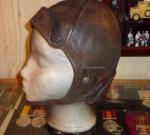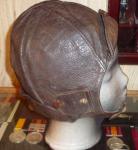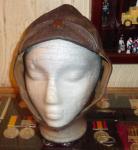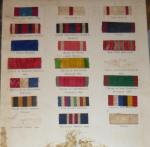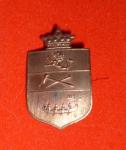-
Posts
2,111 -
Joined
-
Last visited
-
Days Won
11
Content Type
Profiles
Forums
Blogs
Gallery
Events
Store
Everything posted by QSAMIKE
-
Good Morning Everyone I picked this helmet / hat up during my last European trip..... I have not done anything with it as I was not exactly sure at to what it was, that is officially..... I have shown it to several collectors and the majority think that it may be a World War One, German, Flying Helmet..... I am posting it here to find out what your opinions may be..... To answer some questions in advance: 1. There are no markings of any kind inside or outside that I can find but there may have been a label inside at one time.... 2. The only named item are the snaps, they are made by a company called "STOCKO" which I understand was founded in Germany in 1901 for the manufacture of hollow rivets, eyelets, press fasteners and metal buttons. Therefor the helmet / hat has some parts that could have been made during or even before the World War One period..... So I am going to throw it out to everyone for their comments and opinions...... Oh yes I do understand that there are copies but with the wear and the fastenings I do not think this is a copy..... Mike
-

British Victory Medals
QSAMIKE replied to Kev in Deva's topic in Inter-Allied Victory Medals of the Great War
Hi Gunner...... I have not been able to put my hands on the book right away but will keep on looking..... In fact I remember something being written in the OMRS Journal going way back..... But here is the chart that I have had for over 40 years as it was given to me by a very very early member of OMRS..... Mike -

British Victory Medals
QSAMIKE replied to Kev in Deva's topic in Inter-Allied Victory Medals of the Great War
Good Morning Gunner...... I have seen this medal ribbon in a couple of British Books printed at the time and I also have a ribbon chart with it included..... I understand that there was a bit of controversy between a couple of countries that had their colours missing and even though they were allies in WW1 one country next to another and the decision was made to go to the rainbow colours...... Mike -

Rare Naming on a QSA
QSAMIKE replied to Mervyn Mitton's topic in Great Britain: Orders, Gallantry, Campaign Medals
Hi Marvyn....... Nice Find..... If it is looking for a home....... It will find one here....... Mike -

QSA OXFORD LI
QSAMIKE replied to Jock Auld's topic in Great Britain: Orders, Gallantry, Campaign Medals
Hello Peter....... In answer to your list...... I think and it is my opinion that there were possibly four strikings of the QSA: 1ST TYPE, with dates 1899-1900, is quite rare. A few, for example, were awarded to the first contingent of Lord Strathcona's Horse, a Canadian raised unit..... Was originally and officially called during the Boer War as Strathcona's Horse, the "Lord" did not come into effect until just before WW1..... THERE ARE 64 KNOWN EXAMPLES OF THE RAISED DATE QSA..... BUT NOT ALL WERE AWARDED TO THE STRATHCONA'S..... Other Known Dated Queen's South Africa Medals. Lt.Hon. F.H.S. Roberts, V.C., Natal, Relief of Ladysmith, Killed-in-Action, Colenso December 15th, 1899. This medal is stated to be Un-Named and is located at the National Army Museum. Col. C.F. Mooses A.S.C., Belmont, Modder River, Relief of Kimberly, Paardeberg, Driefontein, Johannesburg, Diamond Hill, Wittebergen, South Africa 1901. 19467 QMS H. S. Smith, RE, Cape Colony, Paardeberg, Johannesburg. 25837 Driver E.J. Budd, 66th Battery Royal Field Artillery, Cape Colony, Tugela Heights, Relief of Ladysmith, Transvaal, Orange Free State. Un-Named medal in Collection in South Africa - No Bars on Medal but has raised dates Un-Named medal in Collection in Canada - Natal, Orange Free State, Belfast, South Africa 1901 THE UNIT THAT ADOPTED THE SPRINGBOK AS A CAP BADGE WAS "THE FIRST CANADIAN MOUNTED RIFLES" WHICH BECAME "THE ROYAL CANADIAN DRAGOONS" ....... I HAVE ATTACHED A PHOTO OF THE STRATHCONA CAP BADGE..... 1a TYPE (aka TYPE 2) IS THE GHOST DATE MEDAL 2nd TYPE (aka TYPE 3) IS WITH THE ARM TO THE "R" WITH NO GHOST DATES 3rd TYPE (aka TYPE 4) IS WITH THE ARM TO THE "F" IN AFRICA Anyway that is my humble opinion as there has always been an argument about 3 or 4 dies..... Mike -

QSA OXFORD LI
QSAMIKE replied to Jock Auld's topic in Great Britain: Orders, Gallantry, Campaign Medals
Good Morning Jock..... This comes up quite often on various sites and forums....... Here is one of my stock answers...... As a collector of QSA's for over 35 years I will not pay any extra for a Ghost Date medal.... I went through my collection a number of years ago and I found the breakdown of 37% type 1a and had Ghost Dates, 63% were type 2 and 3..... Note: not including my Three Dated medals LOL..... In checking prices there was no real difference between the two so far as price was concerned..... I have seen dealer lists where they have 2 medals one Ghost and one not to the same regiment with the same bars and the Ghost medal is 30% higher and all I do is shake my head..... Mike -

QSA OXFORD LI
QSAMIKE replied to Jock Auld's topic in Great Britain: Orders, Gallantry, Campaign Medals
Good Morning Paul..... I concur the Oxford medal that I have with just 2 bars was purchased in 2002 for the sum of $100.00...... Mike -
Hi Timo...... I sold a silver one on ebay about 2 years ago and got 24.00 Pounds for it...... I have seen a Silver, Bronze and White Metal version...... Worth more if they had the original box...... Here are a couple on ebay right now..... Mike http://www.ebay.com/itm/Rare-WW1-1916-Britian-Navy-Battle-of-Jutland-Medal-Gilt-Silver-No-Reserve-/190920016283?pt=UK_Collectables_Militaria_LE&hash=item2c73b8419b http://www.ebay.com/itm/SUPER-JUTLAND-MEDAL-SPINK-SON-1916-31st-MAY-/281170231531?pt=UK_Collectables_Militaria_LE&hash=item41770d40eb
-

Anglo Boer War - RAMC records
QSAMIKE replied to Kerry Langford's topic in Great Britain: Research, Documentation & History
Good Morning Kerry...... From the Anglo Boer War Web Site...... The RAMC was formed in 1898 by joining the Medical Staff (officers) and Medical Staff Corps (men). Each brigade of infantry or cavalry upon a war footing has attached to it a medical section, comprising generally three officers and about fifty-seven men, with fifteen various vehicles, of which ten were hospital wagons. In Battle, the wounded were conveyed to the dressing stations by the ambulances and ambulance men. After receiving treatment they were either returned to their unit or referred to a field hospital for more care. Each division had its own field hospital. An army corps had 10 field hospitals, each with a capacity of 100 men. The personnel of the field hospital consists of five officers, a warrant officer, and thirty-four non-commissioned officers and men, with six horses, and a number of vehicles for provisions, water, medical stores, equipment, and reserve rations. The wounded were retained in the field hospitals and their injuries attended to until they can be transported to the hospitals upon the lines of communication or at the base. The reality of war often meant the provision for the sick and wounded was inadequate. For example, at Modder River, a capacity of two field hospitals had to deal with 800 patients. In addition to their medical duties, the RAMC had responsibility for hygiene, sanitation and water supplies etc. In his despatch of 2nd April 1901 Lord Roberts said: "Under Surgeon General Wilson this department has laboured indefatigably both in the field and in the hospitals. Some cases have been brought to my notice in which officers have proved unequal to the exceptional strain thrown upon them by the sudden expansion of hospitals, and in the earlier stages of the war the necessity of more ample preparations to meet disease were not quite fully apprehended. These cases have been fully reported on by the Royal Commission, and will no doubt receive the attention of his Majesty's Government. I am not, however, less conscious of the unremitting services of the great majority of the officers of the Royal Army Medical Corps. There are many instances, indeed, recorded of great gallantry having been displayed by the officers in carrying on their work of mercy under heavy fire, and in the face of exceptional difficulties their duty has been ably performed. My thanks are also due to the distinguished consulting surgeons who have come out to this country, and by their advice and experience materially aided the Royal Army Medical Corps. The services rendered by Sir William MacCormac, Mr G H Makins, Mr F Treves, the late Sir W Stokes, Mr Watson Cheyne, Mr G Cheatle, Mr Kendal Franks, Mr John Chiene, and Sir Thomas Francis Fitzgerald, were of incalculable value. The abnormal demand upon the RAMC necessitated the employment of a large number of civil surgeons, and to these gentlemen the army owes a debt of gratitude. The heavy strain on the Army Medical Department was further much relieved by the patriotic efforts of the several committees and individuals who raised, equipped, and sent out complete hospitals". Lord Roberts also mentions the invaluable assistance by the British Red Cross Society, who equipped hospital trains, and he also speaks of the value of the hospital ships. As to the nursing sisters he says, "It is difficult to give expression to the deep feeling of gratitude with which the nursing sisterhood has inspired all ranks serving in South Africa". The outcry raised at the time when the army was posted about Bloemfontein, and enteric was ravaging its ranks, may not have been entirely justified, in that it overlooked some insuperable difficulties; but, on the whole, it is fortunate that public attention was engrossed with a subject of such importance, and the agitation did good, in that it made the path of the reformers more easy. That some reforms were necessary is beyond doubt, and that these have been undertaken is a matter of satisfaction. Apart from all authorised or Red Book reforms, perhaps the most desirable consummation is that our fighting generals should realise that in a campaign of any duration their own power will greatly depend on the observance of sanitary rules. Medical officers should not be discouraged from urging and compelling the frequent changing of camping-grounds, and, in the selection of these, wholesome water-supplies must ever be a sine qua non (see ' A Doctor in Khaki', by Dr E Freemantle: Murray, 1901. The author was a civil surgeon, and his work is a very valuable contribution to the literature on the subject). THE Medical Department of the Army was less affected than others by the change which at the end of 1900 was occurring in the character of the war. Up to then the maintenance in efficiency of the medical field units and the establishment of hospitals behind the central force advancing towards Pretoria had been of equal importance. With the occupation of Johannesburg and Pretoria, and the establishment of large hospitals in those places, the further advance to the east and the irregular movements which took place both in the Transvaal and the Orange River Colony had little effect on the hospital arrangements. The main centres were already established, and the changes which took place in them were a mere development of their resources. But inasmuch as the number of columns was now increased while their individual strength was reduced, so additional but smaller medical field units were required. Moreover, as it was impossible to say when and where concentrations of troops might take place, all the hospitals in the Colonies had to be maintained almost at their maximum accommodation, so as to provide for sudden demands for beds consequent on the arrival of a large body of troops. This resulted in local excesses of permanent accommodation, and a dispersion of personnel, where, had the circumstances been different, a concentration both of beds and staff would have been economical. As the campaign continued, certain districts became quieter, and it was possible to reduce some hospitals in order to enable others to be opened at a distance from the trunk lines, so that the latter might be in touch with the troops as these gradually pushed further into the field and came less frequently to the railway; and finally the development of the system of lines of blockhouses enabled hospitals to be maintained and relieved of their sick by convoy. The subjoined tables will show the places at which hospitals existed, and the dates on which they were opened and closed. [For this information, click here] In November, 1900, cases of plague occurred among natives near King Williams Town, and the Principal Medical Officers of the lines of communication and the base were warned to watch for suspicious cases, and to take precautions. In January, 1901, plague appeared at Cape Town at the docks, and thence spread to the native, and later to the European, population of the city. This was a serious complication, for Cape Town was the principal port for disembarkation of troops and for the discharge of foodstuffs. The preventive measures put in force were the following : (1) Cape Town, as far as possible, ceased to be a port of discharge for supplies. A complete stoppage could not be effected owing to the needs of the western line, and of the troops in Cape Colony itself, but every precaution was taken in the supply depots to limit the possibility of infection being conveyed by foodstuffs, forage, etc. (2) Cape Town was evacuated as far as possible, particularly Greenpoint Camp, which was close to the docks, and provided the largest number of cases. (3) Movements of troops from Cape Town could not entirely cease, but arrangements were made for the inspection of troops passing up country at the various stations at which the trains halted. In April a conference was held at Cape Town to arrange for common action upon the above lines by the military and civil authorities, and a special plague hospital was established at Maitland, with a bacteriological laboratory. The precautions taken against the conveyance of plague by the moving troops were successful. Of some 900 cases of plague which occurred, only twenty-four belonged to the Imperial forces. One only occurred outside Cape Colony, at Mafeking; there was one near Wellington, another at Port Elizabeth, both of which places were in frequent communication with Cape Town. One case also occurred on board ship, between Cape Town and Durban. Of the remaining twenty cases, eleven occurred at Greenpoint, five in Cape Town itself, and four at Maitland. Owing to the multiplication of small columns, the medical field units were reorganised. It was no longer possible to maintain the field hospitals as distinct from the bearer companies. A unit to fulfil both functions was therefore formed by adding ambulance transport to the field hospitals, or by sending additional equipment to the bearer companies. The total strength and equipment of the combined unit was thus reduced, resulting in greater mobility. Tongas were found to be useful, or, in their place, Cape carts or the four-wheeled " spiders." In the operations in Cape Colony the nature of the country made it impossible for wheeled ambulance transport to keep in touch with the troops, and in these conditions, as formerly in Natal and the Eastern Transvaal, the Indian bearers, with dhoolies from the Indian field hospitals, were of service. These men were collected from the various hospitals, and a number of dhoolies were sent down to the colony. The use of small medical units was only rendered possible by the fact that a column was never long away from its advanced base, and that casualties were limited, while the actual distance to some point on the line of communications was never great. At first columns came to the line to refit; later they obtained supplies from advanced bases pushed forward into the veld, and here the advanced hospitals were posted, from which the sick left by the columns were conveyed to the hospitals on the line of communications. When " drives " took place, the hospitals on the line of communications where the " drive " was destined to end, were evacuated so as to make room for the incoming sick, and hospital trains were moved to convenient points so as to meet the columns on their arrival. Local emergencies in various districts often necessitated the sudden formation and despatch, at short notice, of fresh columns, so that at any time an unforeseen demand for a medical unit might arise. One or two units were generally available to meet such demands. Columns were being constantly broken up, leaving a medical unit unattached. An opportunity would thus arise of bringing it into some central position whence it could be railed to the latest point of concentration. It was not, however, always possible to obtain such early intimation of impending movements as would enable medical units to be sent to join new columns. Such personnel, equipment, and transport as were available in the neighbourhood were in these cases hastily concentrated, and an improvised field unit would be formed from them. Continuous movements pressed heavily on the personnel of the medical field units. Many were incessantly in the field during the whole period, except for short delays whilst the columns to which they were attached were refitting. The wastage in personnel was therefore large, and it was often difficult to keep units up to strength. The nucleus was formed of Royal Army Medical Corps N. C. Officers and men, but the rest of the personnel was made up principally of the specially enlisted men of the Royal Army Medical Corps, Cape Medical Staff Corps, and a similar body enlisted under the general term of South African Irregulars, with, for a time, some of the Imperial Hospital and the Imperial Bearer Corps. The part played by the Natal hospitals should be mentioned. From the end of 1900 to the close of the war the medical arrangements in Natal remained unchanged. These hospitals were of much importance, for, as already noted, they received the overflow from the hospitals in the Transvaal. A regular system of evacuation was maintained through Natal, via Durban, to England. Invalids, collected in the hospitals in Pretoria, Johannesburg, and Elandsfontein, from the eastern, northern, and western lines, were transferred by hospital train to the Natal hospitals at Newcastle, Charlestown, Howick, Pietermaritzburg and Pinetown. There, many of the cases recovered, and the rest were sent home by hospital ship or sick transport. From the time when traffic on the line between Elandsfontein and Charlestown had become regular, all the invalids from the Transvaal passed through the Natal hospitals, while all the invalids south of the Vaal passed through Cape Town. The invalids from Harrismith were also sent through Natal, and the hospitals in that colony were thus steadily employed till the end of the war. Both in Natal and Cape Colony hospital camps were established for the reception of officers and men needing rest and change during convalescence, or in the state of exhaustion which induces disease. The chief of these were at Mooi River in Natal, at Wynberg in Cape Colony. The benefits derived were most marked. Many potential invalids were re-equipped for the field, both physically and mentally, by the interlude of quiet thus afforded, whilst many extraordinary recoveries from actual disease were recorded. It is probable that in the future, campaigns of long duration will inevitably demand the institution of such rest camps for the reinvigoration of those whose organisation has temporarily succumbed to the exhausting tension of modern warfare. It had been foreseen that the establishment of officers of the Royal Army Medical Corps would not be sufficient for the needs of the field force, and from the first civil surgeons formed a large proportion of the staff of the general hospitals despatched from England. Later, civil surgeons sent by the War Office, or engaged locally, were employed in every capacity—-in medical charge of regiments, with field medical units, in ambulance trains, in the smaller hospitals, and in charge of posts on the line, as well as in the general and stationary hospitals. Up to the end of 1901, of the total number of medical officers employed, about forty-two per cent, only, were officers of the Royal Army Medical Corps. Of the remainder, about four per cent, were Militia, Volunteer, and Colonial officers, while the remaining fifty-four per cent, were civil surgeons, of whom about forty per cent, were engaged by the War Office. In 1902 the officers of the Royal Army Medical Corps numbered about forty per cent., the War Office civil surgeons about forty-six per cent., and those locally engaged about ten per cent. Before the outbreak of the war there were a number of medical men, who had been in practice in the Transvaal, in the larger towns of the English colonies, especially in Cape Town and Pietermaritz-burg. Many of these, being without employment, at once offered themselves for service as civil surgeons, and were engaged. As the war continued more medical men became available. Some were driven from their practices as the result of the war, others arrived in the country in the hope of obtaining employment. With certain exceptions, practically every medical man who offered himself locally was engaged. In addition to the civil surgeons engaged locally for general service it was always convenient to utilise the services of medical men in practice in many of the smaller towns (especially in the Orange River Colony and Cape Colony), to look after the smaller bodies of troops stationed there, or parties of sick and wounded dropped by the columns in improvised hospitals. Many of these did good work and set free the general service personnel for more urgent duties. The senior medical officer of a column was thus enabled to arrange for the care and custody of the patients whom he left behind. Most of these civil surgeons had considerable local influence among the Boers, and so ensured better treatment for isolated parties of sick than could have been obtained for them by a stranger to the district. The Principal Medical Officer in South Africa recorded his opinion that the civil surgeons sent out from England at the beginning of the war were, on the whole, more efficient than the majority of those who came out later, the latter being for the most part young men, fresh from the hospitals ; and that, of the civil surgeons engaged in Africa, some were exceptionally good men, whose local knowledge, and practical experience of the country, were particularly valuable. In addition to the civil surgeons, a certain small proportion of colonial medical officers were employed during the war. Most of these belonged to certain units, e.g., the Canadian Field Hospital, the New South Wales Ambulance, and the Cape Medical Staff Corps. Mike -

POW listings - UK units?
QSAMIKE replied to Stijn David's topic in Great Britain: Research, Documentation & History
That's just it Peter...... They are on line or at least can be searched and that is what I cannot find..... -
Good Morning Everyone...... This is not in my field of collection but was so interesting that I had to pick it up...... United States Army, Medical Corps, Diagnosis Tags....... Dated June 1918..... The main interesting thing other than the item itself is that it has never been used..... There is some wear on the booklet from most likely being in some medic's kit bag but I guess he was never in a situation where he had to use them..... For your enjoyment..... I should mention size: 5 1/2 Inches by 2 1/2 Inches Mike
-

POW listings - UK units?
QSAMIKE replied to Stijn David's topic in Great Britain: Research, Documentation & History
Gentlemen..... I read on a forum somewhere and I have been trying to find it, that there are index cards made by all sides during WW2 that were passed to the Red Cross in Switzerland giving all the details of each POW, no matter what country..... That is if the person was reported as I am sure not all were..... These have now been made available to researchers and historians, I am trying to find the post as to where to contact..... Mike -
This has shown up on ebay and just thought I would bring it to everyone's attention and maybe help the PPCLI Museum to get it for their collection as they have his other medals..... http://www.ebay.ca/itm/281178156144?ssP ... 1438.l2649 I have no connection with the seller..... Mike Additional Information: A web page has been set up to help raise money to buy the Memorial Cross for the Regiment " Sgt. Spall VC, Memorial Cross fund"
-

Is this cloth insignia from Canada?
QSAMIKE replied to Noor's topic in Great Britain: Militaria: Badges, Uniforms & Equipment
Good Morning Noor...... Sorry but this is not Canadian according to any of the books that I have....... Mike -
Good Evening Everyone....... Back from saleing and going to a few flea markets again this weekend..... On to France on Monday...... Thought I would share with you my finds....... 1) Occupation Money, Mint and Uncirculated - Germany (Understand this is fairly common) 2) Westerbrok Transit / Internment / Concentration Camp Money Mint and Uncirculated - The Netherlands understand this is quite Rare in this condition..... 3) A couple of unopened packages of Cigarettes from the 1940's - The Netherlands, thought that these were not that common as the seller only had one on display and after I bought it he pulled out 5 more packages but then again the two packages for 7 and a half Euros I will not complain..... 4) A pair of Dutch Afghanistan patches..... 5) Unknown and Un-labeled Leather Helmet...... Mike



